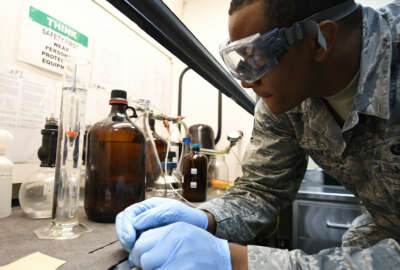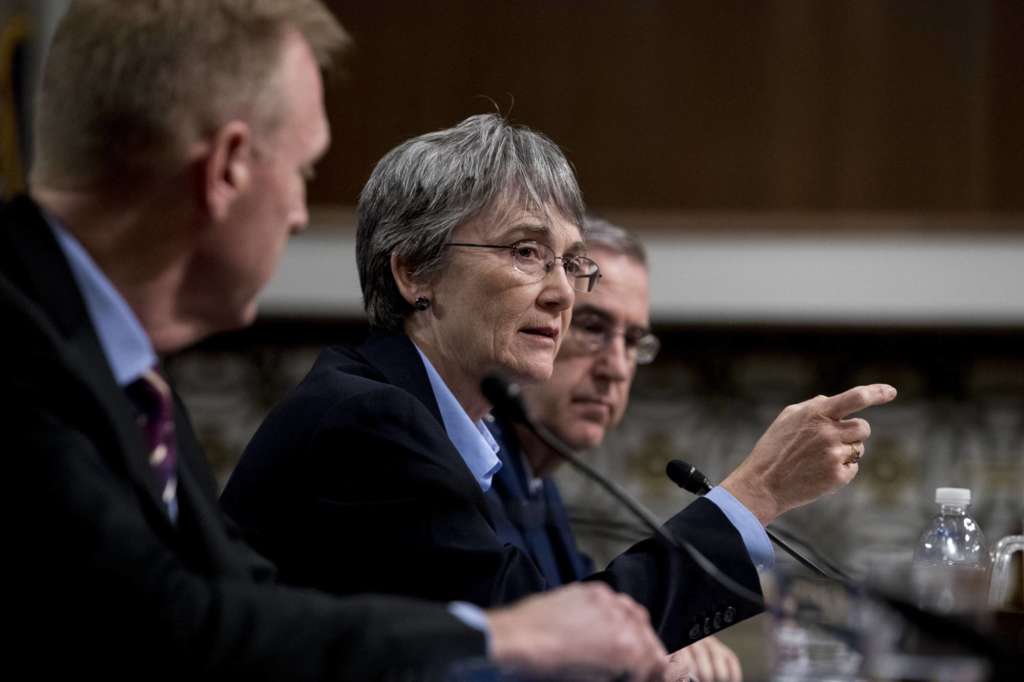

The new science and technology strategy dictates how the Air Force will invest in research through 2030.
Best listening experience is on Chrome, Firefox or Safari. Subscribe to Federal Drive’s daily audio interviews on Apple Podcasts or PodcastOne.
The Air Force will create a new top technology officer position, changing the way it promotes its airmen and invests more heavily in vanguard technologies as part of its new science and technology strategy.
The strategy is the culmination of a year and a half of work by Air Force officials to find better ways to invest the service’s $2.8 billion in S&T funds into 2030.

Air Force Secretary Heather Wilson said Wednesday at the Pentagon that part of investing better is creating a strong focus for research advocacy at high levels.
“We need a chief technology officer to elevate the advocacy for science and technology and ensure it’s integrated in the way we are developing the future force,” Wilson said.
The new position is different than the current Air Force chief technology officer; the current job is under the chief information officer.
The new job will be a headquarters position filled by a Senior Executive Service employee, and will be in charge of S&T accounts and employees. This position will also integrate and prioritize with the major commands and acquisition authorities, and reach out to academia and industry.
While the strategy creates a new fulcrum for S&T, it also guides the Air Force in how to invest those mission funds. The strategy suggests investing 20 percent of research funds into vanguard technology.
“Vanguard programs will be limited in time and scope to achieve focus and urgency. While emphasizing advanced technology, they can synergize applied research, selected basic research, and experimentation and prototyping to drive forward innovative capabilities,” the strategy states.
Those technologies are not clearly defined, however. Instead they are concepts the Air Force wants to get its arms around. They include global persistent awareness; continuous and timely knowledge of adversaries; complexity, unpredictability and mass; overwhelming adversaries through a collaborative and autonomous network of systems; and the ability to rapidly disrupt and neutralize dynamic and mobile targets using new methods to attack with speed and global reach.
“One of the things this strategy doesn’t do is say, ‘Here’s the answer, go research this particular topic,’” Wilson said. “It tries to lay out what we think are complex problems or things we need to dominate and encourages research and development in those areas.”
The point, Wilson said, alluding to the current hockey playoffs, is to shoot not where the goalie is but where the goalie isn’t.
“The idea as part of this strategy is to assess where our adversaries can’t easily go and get there first and fastest,” Wilson said. “That is a winning strategy and I think hockey is the best way to play that. That and you play where the puck is going to be.”
In an attempt to keep more scientific-focused airmen in the service, the strategy also makes the Air Force’s promotion system more flexible.
The Air Force will create seven promotion consideration categories based on occupation. The hope is to give airmen better benchmarks for promotion in their specialty, rather than having everyone meet the same criteria.

She added that the changes will have a profound impact on the Air Force in 10 years.
“It will allow us to highlight and develop more scientific and technical expertise,” she said. “It’s not unusual for a young captain to say to their commander, ‘I really want to go back and get my Master’s in electrical engineering or my Ph.D.’ and the answer, usually, from their boss is, ‘You’re a great officer. Don’t get off the ladder because we really need you as a senior officer in our service and getting that Ph.D. will hurt you.’ It should never hurt an officer to put themselves forward in higher education that they need and it currently does.”
The Air Force is also setting up a Ph.D. Management Office to handle those who hold doctorates with the same care it has for general officers.
“It’s not just that you are a maintenance officer, but you’re a maintenance officer with a Ph.D. in artificial intelligence,” Wilson said. “That requires more care and attention and stewardship in your career.”
Copyright © 2024 Federal News Network. All rights reserved. This website is not intended for users located within the European Economic Area.
Scott Maucione is a defense reporter for Federal News Network and reports on human capital, workforce and the Defense Department at-large.
Follow @smaucioneWFED
